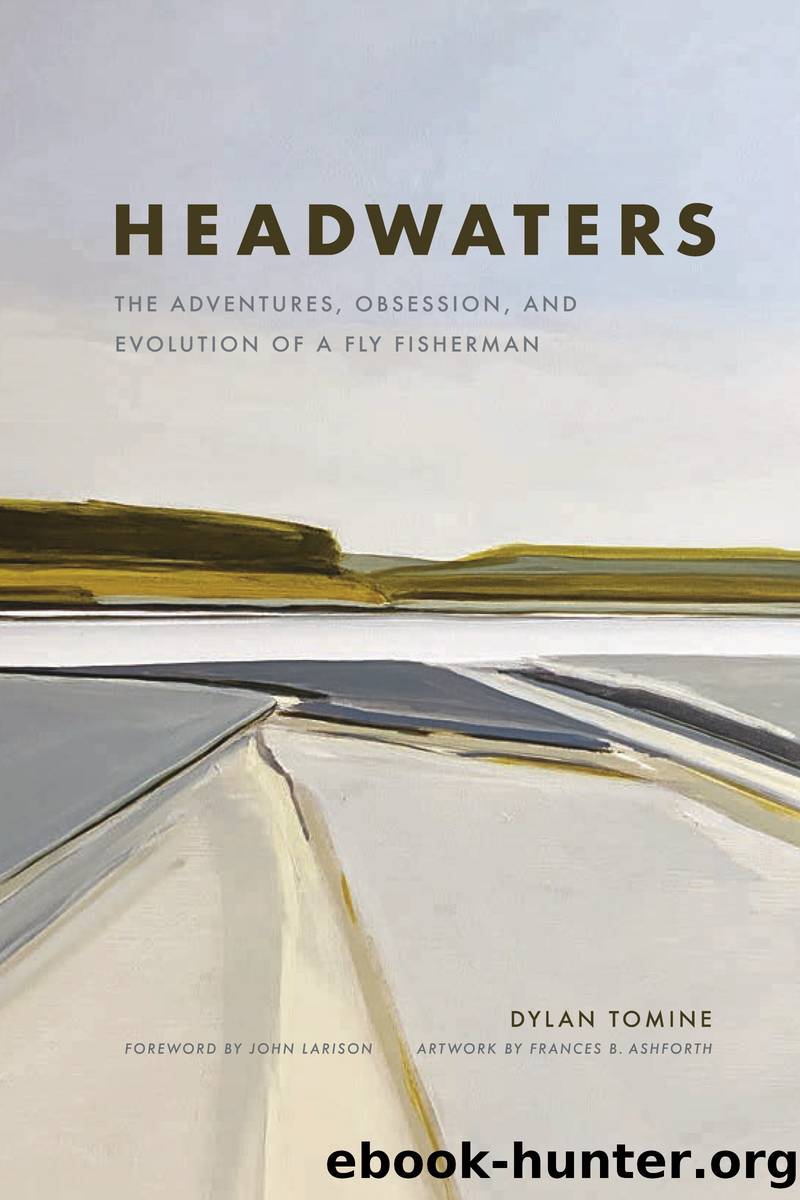Headwaters by Dylan Tomine

Author:Dylan Tomine
Language: eng
Format: epub
Publisher: Patagonia
TROUBLE IN PARADISE
The dream is always the same. Mist clings to steep, heavily forested slopes descending to the music of moving water. The river runs a slightly milky, emerald green with glacial tint, choppy over cobbled bottom, then glides downward, smoothly heeding the pull of gravity. Somewhere out there, moving invisibly against the flow like chrome ghosts, swim steelhead.
This is the mighty Hoh River, crown jewel of the Olympic Peninsula, a dream for all who feel the jones of wild fish and the swung fly. And while many consider the OP the last stronghold of healthy wild steelhead in the Lower 48, there is trouble brewing here. Even the pristine Hoh, its headwaters fully protected by Olympic National Park, is hanging by a thread. In fact, wild Hoh River winter-steelhead runs have fallen below escapement goalsâthe management target for minimum number of spawners required to sustain the populationâin four of the last seven years.
In 2009, the incredibly productive âsteelhead factoryâ of the Quillayute system, made up of the Sol Duc, Bogachiel, Calawah, and Dickey Rivers, was 20 percent below its wild winter-steelhead escapement goal. Wild summer steelhead in this watershed, as well as those of the Quinault, are teetering on the brink of extinction, with frequently fewer than fifty fish returning to each stream. The fish we love are no longer swimming upstreamâtheyâre circling the drain.
How can this be, in a remote and lightly populated region, with no dams, urban development, suburban sprawl, major industrial facilities, or agricultural water issues?
The problems start with an arrogant notion that we humans can somehow do better than Mother Nature. Despite the best available science clearly demonstrating the negative impact hatchery fish have on wild steelhead populations, state and federal agencies continue to spend millions of dollars on hatchery production here. This is potentially the lowest return on investment of any state expenditureâthe fish come back in abysmally low numbers, they race to the hatcheries en masse, provide little sportfishing value in the rivers, and have a devastating impact on wild steelhead.
The harmful effects of hatchery fish occur at nearly every stage of life. The mass migration of hatchery steelhead smolts outcompetes wild fish for available resources, and as we are learning with the current IHN virus outbreak, they may also be vectors for harmful pathogens. After decades of nonselective fisheries targeting hatchery adults, the early DecemberâJanuary component of the wild steelhead runs have been decimated as bycatch. Even worse, unharvested adult hatchery fish interbreed with the remaining wild steelhead, introducing faulty genes and weakening the population. The study by NOAA scientists on the Oregon coast only confirms what we already knew: genetic pollution from hatchery programs is the primary cause of declining wild steelhead runs.
And remember, weâthe taxpaying citizensâare paying for these results. Hard to believe at a time when severely reduced state budgets are forcing school closures and drastic cutbacks on critical services across the board.
Why do we continue to waste money on hatcheries? Harvest. Which, on the OP, occurs in two different forms: sport and tribal.
Download
This site does not store any files on its server. We only index and link to content provided by other sites. Please contact the content providers to delete copyright contents if any and email us, we'll remove relevant links or contents immediately.
Sapiens: A Brief History of Humankind by Yuval Noah Harari(14254)
The Tidewater Tales by John Barth(12609)
Mastermind: How to Think Like Sherlock Holmes by Maria Konnikova(7229)
Do No Harm Stories of Life, Death and Brain Surgery by Henry Marsh(6891)
The Thirst by Nesbo Jo(6831)
Why We Sleep: Unlocking the Power of Sleep and Dreams by Matthew Walker(6618)
Life 3.0: Being Human in the Age of Artificial Intelligence by Tegmark Max(5476)
Sapiens by Yuval Noah Harari(5294)
The Longevity Diet by Valter Longo(5021)
The Body: A Guide for Occupants by Bill Bryson(4976)
The Rules Do Not Apply by Ariel Levy(4863)
The Immortal Life of Henrietta Lacks by Rebecca Skloot(4526)
Animal Frequency by Melissa Alvarez(4395)
Why We Sleep by Matthew Walker(4361)
The Hacking of the American Mind by Robert H. Lustig(4319)
Yoga Anatomy by Kaminoff Leslie(4308)
All Creatures Great and Small by James Herriot(4233)
Double Down (Diary of a Wimpy Kid Book 11) by Jeff Kinney(4208)
Embedded Programming with Modern C++ Cookbook by Igor Viarheichyk(4103)
